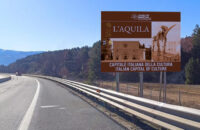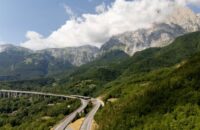The wind that blows impetuously in the Gole di Popoli, between the Peligna Valley and the Marrucino territory, is well known to those who drive along the A25 highway between Popoli and Torre de’ Passeri, but not everyone knows that this wind was also the flywheel of an Italian industrial genius, Corradino D’Ascanio (1891-1981). Renowned for its wealth of water, strategic location among the mountains and windy currents, Popoli Terme, where he was born on the first day of February 1891, provided a stimulating environment for the young D’Ascanio. Even as a child, he showed a lively interest in flying and mechanics, inspired by the natural landscape and climatic conditions of his homeland.
During his childhood, D’Ascanio devoted himself to building models of gliders, trying to imitate the flight of the birds he observed in the Abruzzo skies, eventually building a rudimentary hang glider when he was only 15 years old, which he experienced firsthand in the enchanted landscape of the nearby Sorgenti del Pescara Regional Nature Reserve. This early passion for aviation prompted him to undertake studies first at the Ferdinando Galiani Technical Institute in Chieti and then at the Turin Polytechnic, where he graduated in 1914 with a degree in industrial mechanical engineering, a path that would lay the groundwork for his future innovations in aviation and beyond.
In 1914 he enlisted as a volunteer in the Corps of Engineers, in the “Battaglione Aviatori” division in Turin, where he was assigned to engine testing and collaborated in starting the production of “La Rhone” engines in Italy. Thanks to his genius, the first radio transmitter is installed on Italian military aircraft and a mechanism for heating airplane engines to inhibit oil freezing is applied.
In 1916, while on temporary leave, D’Ascanio was engaged in work for the company of engineer and pilot Ottorino Pomilio and helped build prototypes of fighter and combat aircraft.
In 1917, in order to communicate with his future wife Paola Paolini in Popoli, where the telephone did not yet exist, D’Ascanio installed an ingenious telecommunications system that took advantage of the electric network of public lighting.
In 1918 D’Ascanio landed in the United States of America following the Pomilio factories that moved there, giving birth to the Pomilio Brothers Corporation. Relations with the new company, however, were not smooth, so the engineer from Abruzzo sought another way to establish himself in the world of aeronautics. It was under these circumstances that D’Ascanio met Ugo Veniero, son of Gabriele D’Annunzio and employed in Detroit by Caproni Airlines. From their collaboration comes a small plane that for lack of funds will never enter production so that the American experience proves unsatisfactory and in late 1919 D’Ascanio returns to Italy.
D’Ascanio’s multifaceted ingenuity
D’Ascanio is remembered mainly for two major inventions: the first production helicopter for Agusta and the famous Vespa scooter for Piaggio. Although his name is often associated with the Vespa, D’Ascanio planted prolific seeds in the field of aeronautical engineering. After designing his first aircraft, he devoted himself to developing control mechanisms for helicopters, obtaining numerous patents. Right in his Abruzzo region, D’Ascanio began a collaboration with the firm G. Camplone & Figli of Pescara to develop his first helicopter prototypes. The firm, which specialized in machinery manufacturing and metal casting, made its workshops and workers available to build and assemble the mechanical parts needed for the helicopter prototypes. This technical support was crucial for the development of the D’AT1 and D’AT2 helicopter models, and later for the D’AT3, which achieved important flying records.
His collaboration with Enrico Piaggio later led to the creation of the Vespa in 1946, a symbol of rebirth for postwar Italy. In addition to his most celebrated inventions, D’Ascanio contributed to the development of thespeed camera, a device still fundamental to road safety. This instrument, originally designed to measure the speed of aircraft, was adapted for road use, once again demonstrating his ability to innovate and adapt existing technologies to new contexts.
The engineer was also able to express his talent in the field of communication and marketing. He was responsible for some of the most original and creative display installations at two-wheeler shows and fairs in which Vespa participated. These installations were true “tricks” designed to amaze the public and leave a lasting impression. Among his most memorable creations are “Vespa on the Peach Branch” and “Vespa on the Water Jet,” which were striking and original visual effects capable of attracting attention and arousing wonder.
Legacy in Abruzzo
In Popoli Terme on Corso Gramsci at the corner of Via Venezia it is now possible to visit his birthplace, in the 18th-century family palace. Thanks in part to his enduring connection, Popoli is now known throughout Italy as the City of Motors, and it is here that the Svolte di Popoli Cronoscalata is held every year, reaching its 63rd edition this year. As further evidence of his ties to his homeland, the City of Montesilvano has named the city’s Liceo Scientifico after Corradino D’Ascanio, and a proposal to set up a Motor Museum in Popoli Terme named after him is being studied in recent months. These awards celebrate his lasting contribution to Italian culture and technology. His legacy lives on, not only in the vehicles he designed, but also in the technological innovation he inspired.







